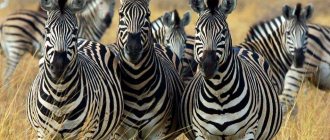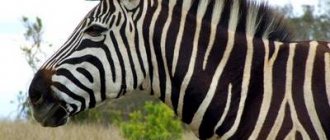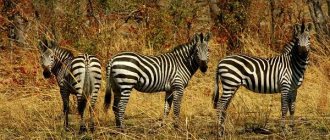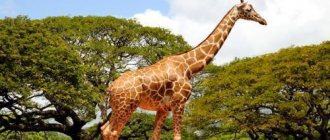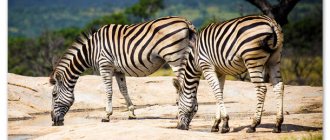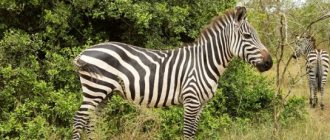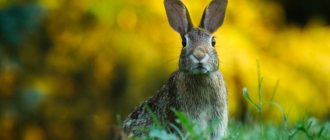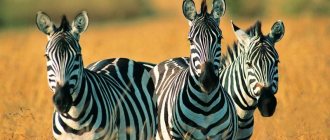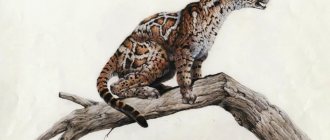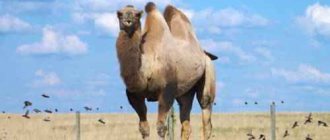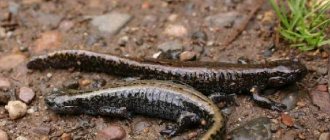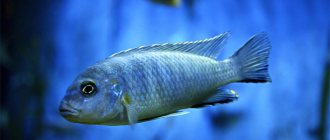- Wild animals
- >>
- Mammals
The quagga is an extinct odd-toed ungulate that once lived in South Africa. The front of the quagga's body had white stripes, like a zebra, and the back had the color of a horse. This is the first and practically the only species (of the extinct ones) that was tamed by people and was used to protect herds, since quaggas were the first of all domestic animals to sense the arrival of predators and inform the owners with a loud, piercing cry of “quaha”, which served as the name for the animal . The last quagga in the wild was killed in 1878.
Origin of the species and description
Photo: Quagga
The quagga was the first extinct animal to have its DNA analyzed. Researchers have confirmed that the quagga is more closely related to zebras than to horses. 3-4 million years have already passed when they had common ancestors with the mountain zebra. In addition, immunological research showed that Quagga was closer to zebras living on the plains.
Video: Quagga
In a study in 1987, scientists suggested that the quagga's mtDNA changed by about 2% every million years, similar to other mammal species, and reaffirmed a close relationship with the plains zebra. An analysis of cranial measurements conducted in 1999 showed that the quagga is as different from the plains zebra as it is from the mountain zebra.
Interesting fact: A 2004 study of skins and skulls revealed that the quagga is not a separate species, but a subspecies of the plains zebra. Despite these findings, plains zebras and quaggas continued to be considered separate species. Although today it is considered a subspecies of Burchell's zebra (E. quagga).
Genetic studies published in 2005 once again indicated the subspecies status of the quagga. It was found that quaggas have little genetic diversity, and that differences in these animals only appeared between 125,000 and 290,000 BC, during the Pleistocene. The distinct structure of the coat has changed due to geographical isolation, as well as adaptation to a dry environment.
Also, lowland zebra subspecies tend to have less striping the further south they live, and the quagga was the most southerly of all. Other large African ungulates have also split into separate species or subspecies due to climate change. Modern plains zebra populations may have originated in southern Africa, and the quagga has much more in common with neighboring populations than with the northern population living in northeastern Uganda. Zebras from Namibia appear to be genetically closest to the quagga.
Appearance and features
Photo: What a quagga looks like
It is believed that the quagga had a length of 257 cm, a height of 125–135 cm at the shoulder. Its coat pattern was unique among zebras, being zebra-like in the front and horse-like in the back. She had brown and white stripes on her neck and head, a brownish upperparts, and a light belly, legs, and tail. The stripes were most distinct on the head and neck, but gradually became weaker until they stopped completely, mixing with the brown-red coloring of the back and sides.
The animal appears to have had some parts of the body that were almost entirely stripless, and other parts that were patterned, reminiscent of the extinct Burchell's zebra, which had stripes over most of the body except the back, legs, and belly. The zebra had a wide dark dorsal stripe on its back, which contained a mane with white and brownish stripes.
Interesting fact: There are five photographs of quaggas taken between 1863 and 1870. Based on photographs and written descriptions, it is believed that the stripes were light on a dark background, which was different from other zebras. However, Reinhold Rau stated that this is an optical illusion, the main color is creamy white, and the stripes are thick and dark. Embryological evidence confirms that zebras were dark with white as an additional color.
Living at the southernmost end of the plains zebra's range, the quagga had a thick winter coat that shed every year. Its skull was described as having a straight profile with a concave diastema with a narrow occiput. Morphological surveys in 2004 showed that the skeletal characteristics of the southern Burchell's zebra and the quagga are identical and that they cannot be distinguished. Today, some stuffed quaggas and Burchell's zebras are so similar that the specimens cannot be positively identified because location data has not been recorded. The female specimens used in the study were, on average, larger than the males.
Where does the quagga live?
Photo: Quagga animal
Native to southern Africa, the quagga was found in large herds in the Karoo and southern Orange Free states. She was the southernmost plains zebra living south of the Orange River. It is a herbivore with a habitat limited to grasslands and arid inland forests that today form parts of the Northern, Western and Eastern Cape provinces. Compared to other parts of Africa, these places had unusual flora and fauna and the highest level of endemism among plants and animals.
Presumably quaggas lived in the following countries:
- Namibia;
- Congo;
- SOUTH AFRICA;
- Lesotho.
These animals were often found on dry and temperate grasslands, and sometimes on wetter grasslands. The quagga's geographic range does not appear to have extended north of the Vaal River. Initially, the animal was extremely common throughout southern Africa, but gradually disappeared to the limits of civilization. In the end it could be found in very limited quantities and only in remote areas, on those sultry plains where wild animals completely dominated.
Quaggas moved in herds, and although they never mixed with their more graceful relatives, they could be found in the neighborhood of white-tailed wildebeest and ostrich. Small groups could often be seen migrating across the bleak, desolate plains that formed their solitary home, in search of lush pastures where they would feast on various herbs during the summer months.
Now you know where the quagga animal lived. Let's see what he eats.
Heather grouse
Birds of the pheasant family lived in the northeastern United States. The grouse was the size of a chicken, ate seeds and was brightly colored.
Several reasons led to the extinction of the species. In their habitat, the birds were often attacked by hawks. Fires reduced the areas where grouse could get food. Agriculture led to the same result. A key factor was the influx of immigrants to the northern regions of the United States. They inadvertently brought with them viruses that were fatal to animals. We also quickly tasted the meat of exotic birds.
Zoologists tried to save unique birds. At the end of the 19th century, they created a protected reserve on the island of Martha's Vineyard. After this, the animal population grew rapidly. But natural disasters did not leave the black grouse a chance: the birds did not survive the terrible forest fires and severe winter cold. The last representative of the species died in 1932.
Heather grouse
What did the quagga eat?
Photo: Zebra quagga
The quagga was more successful at choosing pastures than many of its relatives. Although it often competed with the more numerous wildebeest that lived in the same areas. Quaggas were the first herbivores to inhabit tall grass vegetation or wet grasslands. They ate almost entirely grass, but sometimes ate bushes, twigs, leaves and bark. Their digestive system allowed them to have a diet consisting of plants of lower nutritional quality than required by other herbivores.
The flora of southern Africa is the richest in the world. 10% of all the world's specimens grow there, amounting to more than 20,000 species. Vast areas are fragrant with amazing herbs, bushes, flowers (80%), which are not found anywhere else. The flora of the Western Cape is richest, with over 6,000 flowering plants.
Apparently, quaggas ate plants such as:
- lilies;
- amaryllis;
- iris;
- pelargoniums;
- poppies;
- Cape boxwood;
- ficus;
- succulents;
- heathers, which number more than 450 species, etc.
Previously, numerous herds of quaggas shook the space of the South African savannas with the clatter of their hooves. Artiodactyls led a nomadic life, constantly moving in search of food. These herbivores often migrated, forming large herds.
Features of character and lifestyle
Photo: Extinct animal quagga
Quaggas were very sociable creatures, forming large herds. The core of each group consisted of family members who lived with their natal herd throughout their lives. To gather scattered members of the community, the dominant male of the group made a special sound, which was responded to by other members of the group. Sick or crippled individuals were tended by all members of the group, who slowed down to match the slowest relative.
Each of these herds controlled a fairly small territory of 30 km². When migrating, they could cover long distances of more than 600 km². Quaggas were typically diurnal, spending their nighttime hours in small grasslands where they could spot predators. At night, members of the group woke up one after another to graze for about an hour, without moving far from the group. Additionally, they always had at least one gregarious member of the community to keep an eye out for potential threats while the group slept.
Interesting fact: Quaggas, like other zebras, had a daily hygiene ritual in which individuals stood side by side, biting each other in hard-to-reach places such as the neck, mane and back, in order to rid each other of parasites.
The herds made regular trips from sleeping areas to pastures and back, stopping to drink water at midday. However, little information remains about the behavior of the quagga in the wild, and it is sometimes unclear which species of zebra is referred to in older reports. It is known that quaggas gathered in herds of 30-50 pieces. There is no evidence that they interbred with other zebra species, but they may have shared a small part of their range with Hartmann's mountain zebra.
Falkland fox
Predators lived on the Falkland Islands, which is why they got their name. As with the dodo, Falkland foxes had no problems before humans arrived on the islands. Foxes ate carrion, birds, insects and plants. In the archives, zoologists note that the fox could bark like a dog.
The extinction of the species was predicted by Charles Darwin back in 1833. After visiting the Falkland Islands, he noted the rapid pace of uncontrolled extermination of foxes by hunters. The main reasons are their threat to sheep herds and their unique reddish-brown fur. For the foxes, the arrival of Scottish colonialists on the island was also a disaster because they had nowhere to hide - there are no forests on the islands.
In addition, the predator did not show aggression and was trusting, because before people arrived on the islands it had no enemies on its territory. The last representative of the species died in 1876.
Falkland fox
We talked about what the Black Book is and talked about its most prominent representatives. We hope that soon this section of the Red Book will cease to be replenished and people will finally learn to appreciate the benefits of nature, carefully protect representatives of rare species and wisely treat the planet on which we live. Fortunately, global trends in animal protection and conservation are encouraging.
Social structure and reproduction
Photo: Baby quagga
These mammals had a polygynous, harem-based mating system, where one adult male controlled a group of females. To become the dominant stallion, a male had to take turns luring females from other herds. Stallions could gather around a herd that included a mare in heat, and fight for her with the herd male and with each other. This happened 5 days every month for a year until the mare finally conceived. Although foals can be born in any month, there was a definite annual birth/mating peak in early December–January that corresponded with the monsoon season.
Interesting fact: The quagga has long been considered a suitable candidate for domestication, since it was considered the most docile of the zebras. Imported workhorses did not perform well in extreme climates and regularly fell victim to the dreaded African Equine Disease.
Female quaggas that were in good condition bred at 2-year intervals, having their first baby between 3 and 3.5 years of age. Males cannot breed until they are five or six years old. Quagga mothers looked after the foal for up to a year. Like horses, baby quaggas were able to stand, walk, and suckle soon after birth. At birth, the cubs were lighter in color than their parents. The foals were guarded by their mothers, as well as the lead stallion and other females in their group.
Bali tiger
Another subspecies that suffered a sad fate. The tiger lived exclusively in Bali, and its closest (both territorially and in terms of family ties) brother, the Javan tiger, lived on the neighboring island of Java.
The Bali tiger was not large in size: adult males weighed up to 100 kg, and females - up to 80 kg. The predators lived well side by side with the local population of the island until the hunter Oscar Voynich arrived on it. He marked the beginning of the extermination of the species, although there were no particular reasons for this. The inhabitants of the island simply wanted to follow the example - they were interested in the process of hunting a dangerous animal. Unfortunately, the Bali tigers were exterminated in just 25 years.
Natural enemies of quaggas
Photo: What a quagga looks like
Initially, zoologists suggested that the function of alternating white and black stripes in zebras was a defense mechanism against predators. But in general, it is unclear why the quagga did not have stripes on its hindquarters. It has also been theorized that zebras developed alternating patterns as thermoregulation for cooling, and that the quagga lost them due to living in cooler climates. The problem though is that the mountain zebra also lives in similar environments and has a striped pattern that covers its entire body.
Differences in stripes may also facilitate species recognition during mixing of herds, so that members of the same subspecies or species can recognize and follow their conspecifics. However, a 2014 study supported the hypothesis of a defense mechanism against fly bites, and the quagga probably lived in areas with less fly activity than other zebras. Quaggas had few predators in their habitat.
The main animals posing a danger to them were:
- lions;
- tigers;
- crocodiles;
- hippos.
People became the main pests for quaggas, since it was easy to find and kill this animal. They were destroyed to provide meat and hides. The skins were sold or used locally. The quagga was likely susceptible to extinction due to its limited distribution, and it may have competed with livestock for food. The quagga had disappeared from most of its range by 1850. The last population in the wild, in Orange State, was extirpated in the late 1870s.
Sea (Steller's) cow
The animal was discovered by the German-Russian zoologist Steller during the same Bering expedition in 1741. Externally, the mammal resembled a modern manatee. And it got its name because of its feeding habits: individuals of this species, huddled in groups, slowly swam right at the surface of the water, feeding on kelp.
Sea cows were large in size: their length reached 10 meters and their weight reached 11 tons. They could calmly approach the shore and were not afraid of people. Fame and lack of fear of man did not do them any good: the industrialists who arrived on the islands after Bering’s command easily obtained animals for sale. The meat of the sea cow quickly became popular, so the population of 1.5-3 thousand individuals was destroyed in just 30 years.
Sea (Steller's) cow
